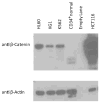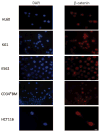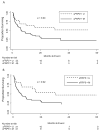Acute myeloid leukemia is characterized by Wnt pathway inhibitor promoter hypermethylation
- PMID: 20795789
- PMCID: PMC4000011
- DOI: 10.3109/10428194.2010.496505
Acute myeloid leukemia is characterized by Wnt pathway inhibitor promoter hypermethylation
Abstract
Nuclear localization of non-phosphorylated, active beta-catenin is a measure of Wnt pathway activation and is associated with adverse outcome in patients with acute myeloid leukemia (AML). While genetic alterations of the Wnt pathway are infrequent in AML, inhibitors of this pathway are silenced by promoter methylation in other malignanices. Leukemia cell lines were examined for Wnt pathway inhibitor methylation and total beta-catenin levels, and had frequent methylation of Wnt inhibitors and upregulated beta-catenin by Western blot and immunofluorescence. One hundred sixty-nine AML samples were examined for methylation of Wnt inhibitor genes. Diagnostic samples from 72 patients with normal cytogenetics who received standard high-dose induction chemotherapy were evaluated for associations between methylation and event-free or overall survival. Extensive methylation of Wnt pathway inhibitor genes was observed in cell lines, and 89% of primary AML samples had at least one methylated gene: DKK1 (16%), DKK3 (8%), RUNX3 (27%), sFRP1 (34%), sFRP2 (66%), sFRP4 (9%), sFRP5 (54%), SOX17 (29%), and WIF1 (32%). In contrast to epithelial tumors, methylation of APC (2%) and RASSF1A (0%) was rare. In patients with AML with normal cytogenetics, sFRP2 and sFRP5 methylation at the time of diagnosis was associated with an increased risk of relapse, and sFRP2 methylation was associated with an increased risk for death. In patients with AML: (a) there is a high frequency of Wnt pathway inhibitor methylation; (b) Wnt pathway inhibitor methylation is distinct from that observed in epithelial malignancies; and (c) methylation of sFRP2 and sFRP5 may predict adverse clinical outcome in patients with normal karyotype AML.
Conflict of interest statement
Dr. James Herman is a consultant to and receives research support from OncoMethylome Sciences. The terms of this arrangement are being managed by the Johns Hopkins University in accordance with its conflict of interest policies.
Figures





Similar articles
-
Wnt signaling pathway is epigenetically regulated by methylation of Wnt antagonists in acute myeloid leukemia.Leukemia. 2009 Sep;23(9):1658-66. doi: 10.1038/leu.2009.86. Epub 2009 Apr 23. Leukemia. 2009. PMID: 19387464
-
Epigenetic inactivation of secreted Frizzled-related proteins in acute myeloid leukaemia.Br J Haematol. 2008 Sep;142(5):745-53. doi: 10.1111/j.1365-2141.2008.07242.x. Epub 2008 Jun 3. Br J Haematol. 2008. PMID: 18537968
-
Secreted-frizzled related protein 1 is a transcriptional repression target of the t(8;21) fusion protein in acute myeloid leukemia.Blood. 2011 Dec 15;118(25):6638-48. doi: 10.1182/blood-2011-05-354712. Epub 2011 Oct 26. Blood. 2011. PMID: 22031861
-
Frequent promoter hypermethylation of Wnt pathway inhibitor genes in malignant astrocytic gliomas.Int J Cancer. 2010 Jun 1;126(11):2584-93. doi: 10.1002/ijc.24981. Int J Cancer. 2010. PMID: 19847810
-
Gene methylation in gastric cancer.Clin Chim Acta. 2013 Sep 23;424:53-65. doi: 10.1016/j.cca.2013.05.002. Epub 2013 May 10. Clin Chim Acta. 2013. PMID: 23669186 Review.
Cited by
-
Wnt/ß-catenin: a new therapeutic approach to acute myeloid leukemia.Leuk Res Treatment. 2011;2011:428960. doi: 10.4061/2011/428960. Epub 2011 Dec 1. Leuk Res Treatment. 2011. PMID: 23213543 Free PMC article.
-
RASSF1A hypermethylation is associated with ASXL1 mutation and indicates an adverse outcome in non-M3 acute myeloid leukemia.Onco Targets Ther. 2017 Aug 22;10:4143-4151. doi: 10.2147/OTT.S142528. eCollection 2017. Onco Targets Ther. 2017. PMID: 28860824 Free PMC article.
-
WNT Signaling in Tumors: The Way to Evade Drugs and Immunity.Front Immunol. 2019 Dec 20;10:2854. doi: 10.3389/fimmu.2019.02854. eCollection 2019. Front Immunol. 2019. PMID: 31921125 Free PMC article. Review.
-
APC2 and CYP1B1 methylation changes in the bone marrow of acute myeloid leukemia patients during chemotherapy.Exp Ther Med. 2016 Nov;12(5):3047-3052. doi: 10.3892/etm.2016.3719. Epub 2016 Sep 20. Exp Ther Med. 2016. PMID: 27882114 Free PMC article.
-
PML/RARα-Regulated miR-181a/b Cluster Targets the Tumor Suppressor RASSF1A in Acute Promyelocytic Leukemia.Cancer Res. 2015 Aug 15;75(16):3411-24. doi: 10.1158/0008-5472.CAN-14-3521. Epub 2015 Jun 3. Cancer Res. 2015. PMID: 26041820 Free PMC article.
References
-
- Renneville A, Roumier C, Biggio V, et al. Cooperating gene mutations in acute myeloid leukemia: a review of the literature. Leukemia. 2008;22:915–931. - PubMed
-
- Steffen B, Muller-Tidow C, Schwable J, Berdel WE, Serve H. The molecular pathogenesis of acute myeloid leukemia. Crit Rev Oncol Hematol. 2005;56:195–221. - PubMed
-
- Scholl C, Gilliland DG, Frohling S. Deregulation of signaling pathways in acute myeloid leukemia. Semin Oncol. 2008;35:336–345. - PubMed
-
- Moore MA. Converging pathways in leukemogenesis and stem cell self-renewal. Exp Hematol. 2005;33:719–737. - PubMed
Publication types
MeSH terms
Substances
Grants and funding
LinkOut - more resources
Full Text Sources
Other Literature Sources
Medical
